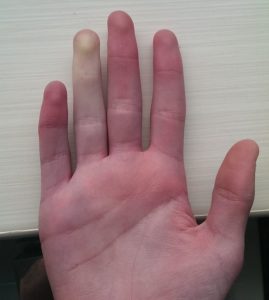If you have ever noticed your fingers or toes get very white, then blue, then red, you may have a condition called Raynaud’s. Raynaud’s affects the blood vessels of both the fingers and toes. Very cold temperatures will cause the small blood vessels to constrict, turning your toes white. As the toes become depleted of oxygen they will begin to turn blue. Once the phenomenon has run its course and your toes are warmed, they will become red as the blood rushes back into them.
Causes of Raynaud’s Disease:
- Primary (Disease)- no medical cause
- Secondary (Phenomenon)- associated with another disease
- Scleroderma
- Lupus
- Rheumatoid Arthritis
- Other
Triggers of Raynaud’s:
- Cold temperatures
- Trauma
- Smoking
- Stress
- Other
If you have Raynaud’s, it is important for you to dress warmly, avoid smoking and caffeine, exercise to increase blood flow, avoid stress, and avoid workplace triggers such as vibrating machinery. Raynaud’s disease can also be treated with blood pressure medications, including calcium channel blockers, alpha blockers, and vasodilators. In addition to seeing a podiatrist for evaluation of your feet, it will be necessary to follow-up with a rheumatologist for further testing and treatment.
Raynaud’s is often confused with a condition known as, chilblains (aka pernio). This is caused by inflammation of the small blood vessels in your fingers and toes when exposed to cold temperatures. It is frequently seasonal and will clear up within a couple of weeks of warmer temperatures. You will also not experience the same color changes to your toes as with Raynaud’s. With chilblains, the primary treatment is to avoid the cooler temperatures.
If you have ever noticed your toes turn different colors, call Hollowbrook Foot Specialists today at (845) 298-9074 for an appointment to evaluate your feet. We are serving the Hudson Valley from Wappingers Falls.


